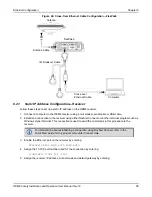
Operation OEM6 Cards and Enclosures
Chapter 4
OEM6 Family Installation and Operation User Manual Rev 12
73
4.10 Additional Features and Information (Card and Enclosure)
This section contains information on additional features of the OEM6 family receivers.
4.10.1 Universal Serial Bus (USB)
OEM6 family receivers come with NovAtel USB drivers for Microsoft Windows 2000, Windows XP, Windows
Vista and Windows 7 to provide three virtual serial ports over a single USB 2.0 connection using USB D(+)
and USB D(-) signals (refer to
Table 10, Available USB Signals on Receivers
on page 73). The USB drivers
are digitally signed and officially supported on Microsoft Windows XP, Windows Vista and Windows 7. They
can also be installed on Microsoft Windows 2000 and Windows Server 2003 but are not WHQL signed in
those applications.
Table 10: Available USB Signals on Receivers
The three virtual serial ports are available to existing Windows applications which use COM ports to
communicate (for example, HyperTerminal and NovAtel Connect). The NovAtel USB drivers assign COM
port numbers sequentially following any existing ports on the computer. For example, if a computer has
COM1 and COM2 ports, the NovAtel USB drivers assign COM3 to USB1, COM4 to USB2 and COM5 to
USB3.
The NovAtel USB Configuration Utility, installed with the NovAtel USB drivers, is used to change the COM
port numbers assigned to the virtual serial ports. Refer to the PC Utilities manual for instructions. You can
also check for updates to the drivers or release notes at
Pin 3 D(-) and Pin 4 D(+) on P1101 (main header). Pin 4
is multiplexed with COM3
Pin 21 D(-) and Pin 22 D(+) of P1500
USB0 (device): Pin 5 (D-) and Pin 3 (D+) of P4001
USB1 (host): Pin 79 (D+) and Pin 81 (D-) of J4101
USB2 (host): Pin 84 (D+) and Pin 86 (D-) of J4101
USB mini connector
For the OEM638, only the USB0 (device) port supports these virtual serial ports. The USB1 and
USB2 (host) ports are used for memory sticks, supplying external storage. The use of external
storage is not supported on the OEM615, OEM617, OEM617D, OEM628 or FlexPak6.
A computer has several USB ports. The assignment of COM port numbers is tied to a USB port
on the computer. This allows receivers to be switched without Microsoft Windows assigning
new COM ports. However, if the receiver is connected to a different physical USB port,
Windows detects the receiver's presence and assigns three new COM port numbers.
The USB ports are particularly sensitive to damage from ESD. NovAtel recommends that
conductors attached to the USB D+ and D- signal pins are terminated.
















































